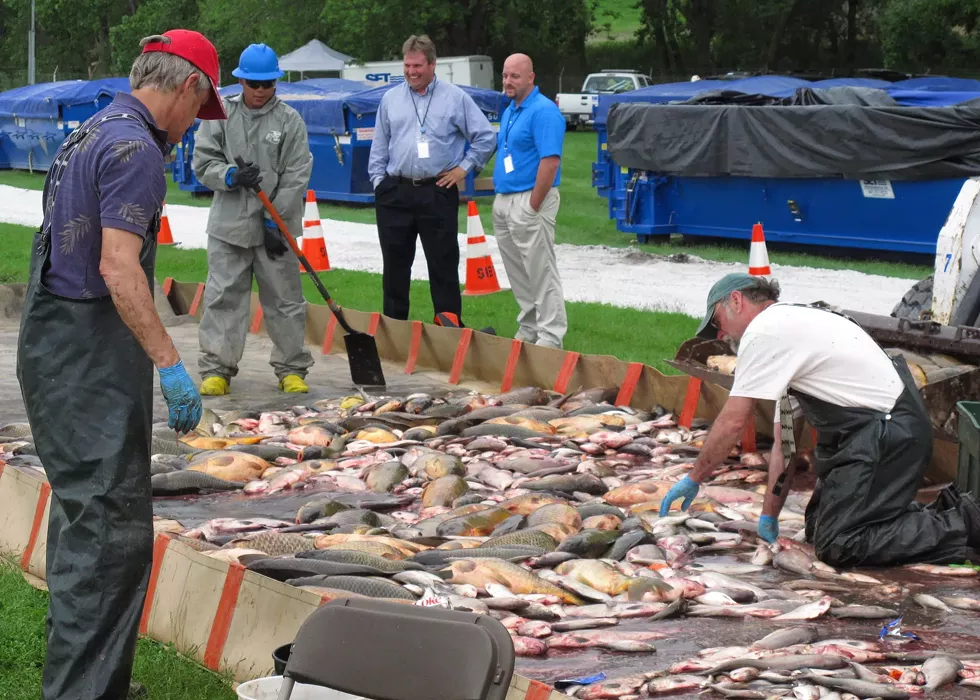
On the gray morning of Dec. 3, 2009, the Chicago Sanitary and Ship Canal looked like a crime scene. Yellow police tape laced the banks. Roads to the water's edge were blocked by police officers shivering in the cold, unable to explain to passersby precisely what had happened. Behind the barricades, a generator thrummed outside a huge government tent with computer workstations and coffee for the 400 federal, state, and Canadian fishery workers who had descended on this industrial corner of Chicago from as far away as Quebec. Just outside the tent, the bosses of the operation corralled the cluster of news reporters at the water's edge to tell their story. They were the ones who had killed the canal, they explained. They had poisoned it because they were at war — with Asian carp.
The first hint that the river was dying came when the fish started to float to the surface, their white bellies aglow in the lifting dawn light. One by one they popped into view, the way stars emerge at dusk. Some could only flap their gills as they drifted on the tea-colored current. Others thrashed. All of them — ultimately a constellation of thousands — would be carcasses by the time the winter sun slipped below the horizon.
"I can sum up my comments in six words: It's time to man the barricades," said the U.S. Fish and Wildlife Service's John Rogner. "For nearly 10 years we've watched as two species of introduced Asian carp — the bighead carp and silver carp — have moved up the Mississippi and Illinois Rivers, and now they are here. They are now at the gates to the Great Lakes and our action over the next several days is designed to protect those gates."
The kill had been ordered because the new barrier needed to be briefly shut down for maintenance. No actual Asian carp had been found within 15 miles of the barrier — about 50 miles from Lake Michigan — but DNA tests were telling biologists that fish were in the canal much closer to the barrier. Even though the original, smaller electric barrier would continue to run during the new barrier's shutdown, Peabody and everybody else in the carp fight wanted the canal sterilized, just in case.
"I'm likening this action to chemotherapy," President Barack Obama's handpicked "Great Lakes Czar" Cameron Davis lamented in the days leading up to the morning the government killed the canal. "Nobody wants to go through chemo, but you do it to protect the good cells from being overridden by the bad cells. That's what this is."
By midmorning on the day of the poisoning, Rogner was assuring reporters the fish kill was going precisely as planned. But there was a problem. Among all the dead bass, bullhead, gizzard shad, suckers, common carp, and catfish bobbing to the surface, no one had found a single Asian carp. Lodge's DNA samples might have told Peabody that the carp were indeed swimming in the poisoned stretch of canal, but the fish floating to the surface told a different story.
Night fell. In all the barrels of toxic carcasses headed for a landfill — ultimately the poisoning of the canal would yield about 54,000 pounds of flesh — there was not even one Asian carp.
Finally, at 7 p.m., Rogner again summoned reporters to the canal's edge. They had found what they were looking for — a single, 22-inch bighead carp. Although it was unsettling news for the Great Lakes that the Asian carp — or an Asian carp — had indeed arrived in the waters just below the barrier, a wave of relief washed over Lodge as word reached the Notre Dame team. The sight of that one fish, he thought, at least validated DNA as a fish-hunting tool. Not everyone was so convinced.
Less than two weeks after the poisoning, a team of federal scientists arrived in South Bend to inspect Lodge's lab. They scrutinized how water samples were stored, how they were filtered, and what steps were taken to ensure Asian carp DNA hadn't somehow contaminated any of the equipment, which could result in false positive results. The Notre Dame team felt a bit like its spouse had hired a private investigator to catch it cheating. The investigators found no such evidence. In fact, they came away impressed, writing in their official report that Lodge's process is "sufficiently reliable and robust in reporting a pattern of detection that should be considered actionable in a management context."
The Notre Dame team took that to mean that if you've got DNA, you've got strong evidence that the fish are there, and you could justify taking action to somehow plug the canal and block others from making the same trip. Still, Peabody wasn't ready to believe that a positive DNA sample in the canal on the lake side of the barrier meant the fish were swimming free into Lake Michigan. The general worried the DNA might have gotten there some other way. Perhaps a barge coming up from the Asian carp-infested waters of the Mississippi basin had somehow picked up Asian carp slime or excrement on its hull. Or maybe the DNA came from the droppings of a migrating bird that had eaten an Asian carp on its way toward Lake Michigan. Or, perhaps, an Asian carp flopped onto the deck of a barge below the barrier, and then flopped off it once the barge passed through.
Peabody knew he was taking a chance adopting a novel, untested technology in a high-stakes fight, but he felt compelled to find out where the fish were so he could make the smartest decision possible about how high to operate the barrier voltage. That was all he wanted from Lodge's DNA sampling. He never expected DNA to surface beyond the barrier, but he was taken aback by the fuss it caused when it did.
"We got a few hits above the barrier," he told me, "and some people were flat-panicked by that."
But it wasn't just "some people." It was the attorneys general from five Great Lakes states who went to federal court in early 2010 to force the Army Corps and the State of Illinois to shut the navigation locks as a last-ditch effort to halt the advance. In just a matter of weeks, the decade-old saga of a giant, leaping type of carp slowly migrating north toward the Great Lakes had gone from a regional news story framed as a quirky situation on a curious river to national news about how two species of carp were tearing apart a region.
"Everybody got into this expecting we wouldn't have any positive samples above the barrier," said Lindsay Chadderton, an invasive species expert from the Nature Conservancy who helped the Lodge team develop and deploy the DNA testing. "The reality is if we had only found positives below the electric barrier...none of this controversy would have happened. The minute we started finding positives above the barrier, that is when the blame game started. That is when the litigation started with the lock closure, and that is when things started to get testy."
The controversy over how much weight should be put on mere molecules floating in water became A-section news in media outlets as far away and as big as The New York Times, which reported that the fight to beat back the fish had so consumed then-President Barack Obama's chief of staff, Rahm Emanuel, that when he returned to Chicago in 2010 to run for mayor, Emanuel's own staff sent him off with a dead Asian carp.
Most biologists acknowledge that a small number of fish advancing beyond the barrier does not mean a self-sustaining Asian carp population in the Great Lakes has arrived, or that one is inevitable. For an invasion to be successful, first the fish have to be sexually mature, then they have to find appropriate spawning areas, then they have to find each other, and then their offspring have to figure out how to survive to adulthood in a new environment and find their own mates. Then the next generation has to have similar success. And so on.
For Peabody, this meant it wasn't time to retreat and move the fight to the locks near Lake Michigan shoreline; it was time to stand his ground at the electric barrier. Meanwhile, Lodge's team continued testing the waters beyond the barrier throughout the spring of 2010, and kept getting more positive DNA hits. Yet fishing expeditions with nets and electroshockers in the same areas continued to turn up zero Asian carp. Desperate to find an actual fish above the barrier and not just its genetic fingerprints, in late May 2010, six months after the first poisoning, the federal government and state of Illinois conducted a second river poisoning just six miles from the Lake Michigan shoreline in an area of water above the barrier that had repeatedly tested positive for Asian carp DNA.
This poisoning claimed another 100,000 pounds of fish representing some 40 species. Not one Asian carp was found. Peabody and the rest of the federal team in the carp fight walked away after the second poisoning more confident that the barrier was holding back the fish, and less confident that Lodge's DNA samples meant fish were in the area.
Peabody and his colleagues with the U.S. Fish and Wildlife Service wanted an actual fish — and not just a lab report — before they would be convinced an actual invasion above the barrier was under way. This is harder than you might expect. Duane Chapman, a United States Geological Survey biologist, once marshaled four boats to chase three radio-tagged Asian carp for two days on a Missouri River tributary using electroshocking gear and commercial fishing nets. The radio tags emitted a signal that told the crew the precise location of the fish, which had been trapped between a set of two nets stretching the entire width and depth of the river. But the water was too deep for the electroshockers to force the fish to surface, and the carp proved cagey enough to avoid getting snarled in the nets.
"They know what nets are," Chapman said, "and they avoid them." Finally, on June 23, 2010, a month after the second river poisoning and about a year after the Army Corps first hired Notre Dame to help it find the leading edge of the invasion, the Illinois Department of Natural Resources announced that a 20-pound adult bighead carp had indeed been caught in a fishing net beyond the barrier — just six miles from the Lake Michigan shoreline. "We set out on a fact-finding mission and we have found what we were looking for," Rogner of the U.S. Fish and Wildlife Service proclaimed in a news release.
Lodge again felt a grim sort of vindication and Illinois' neighboring states clamored louder for lock closure, arguing that the fish was, finally, irrefutable evidence the electric barrier was leaking Asian carp. Then a few weeks later Rogner issued another news release that claimed the fish might have been lifted around the barrier by human hands after a lab analysis showed that apparently it had spent at least some of its life in waters below the barrier. He based this theory on a lab analysis of the carp's ear bones, which can sometimes tell researchers where a fish once lived, because different water bodies leave different chemical signatures on the bone. But not in this case — an independent reviewer of the lab analysis warned that no definitive conclusion could be reached about this particular bighead carp's life history. Even so, the news release claimed that the bone analysis "does suggest to us that the fish...may have been put there by humans, perhaps as a ritual cultural release or through bait bucket transfer."
The problem, beyond the peer reviewer's caution not to use this fish's ear bones to infer anything about its life history, is that an ear bone doesn't contain any information about how a fish moves from one waterbody to another; it can't reveal if a fish traveled in a tank in the back of a pickup truck or if it made the migration on its own. As for the story about a human planting it, bighead carp were at one time sold live in fish markets around Chicago, and rumors of "cultural releases" of Asian carp by people of Asian ancestry practicing some sort of ritual have swirled around Chicago for years. But when I pressed an Illinois Department of Natural Resources spokesman for any evidence of this actually happening with bighead or silver carp in Chicago, the best he could muster was a link to a Wikipedia article. It stated that animal releases were a common practice during the Ming Dynasty in China.
He didn't offer to send me the Wikipedia article that mentioned the Ming Dynasty ended in 1644.






